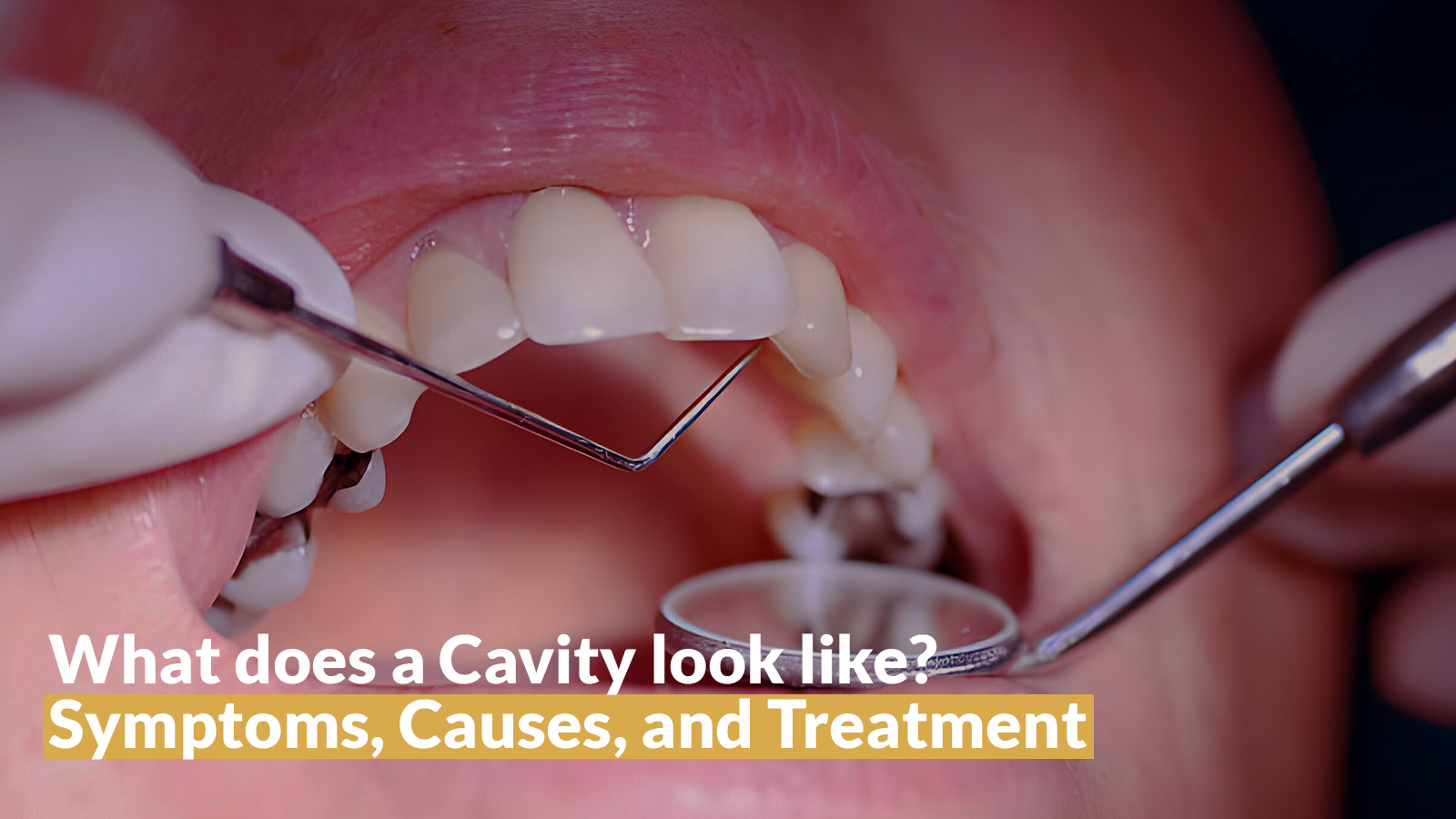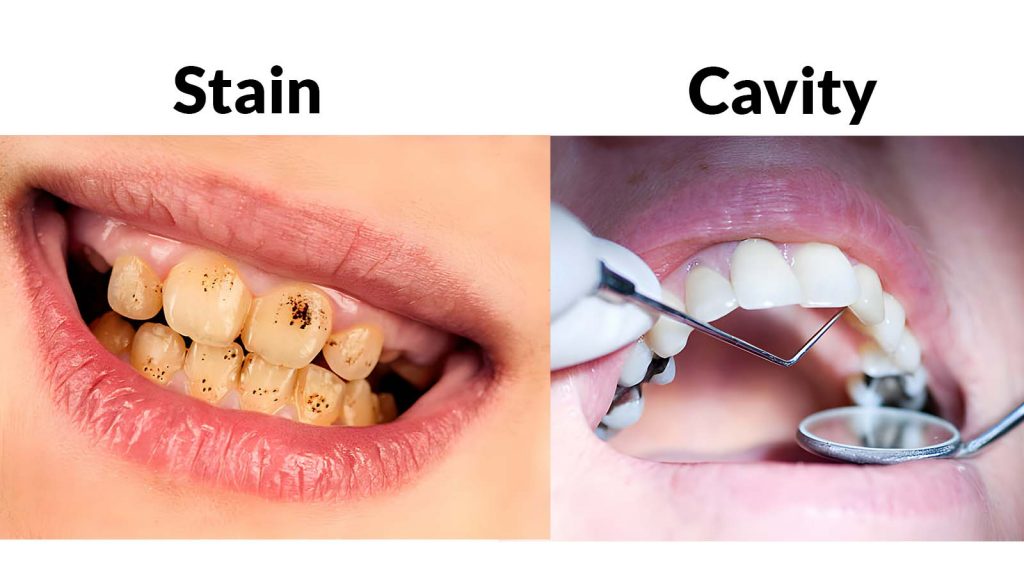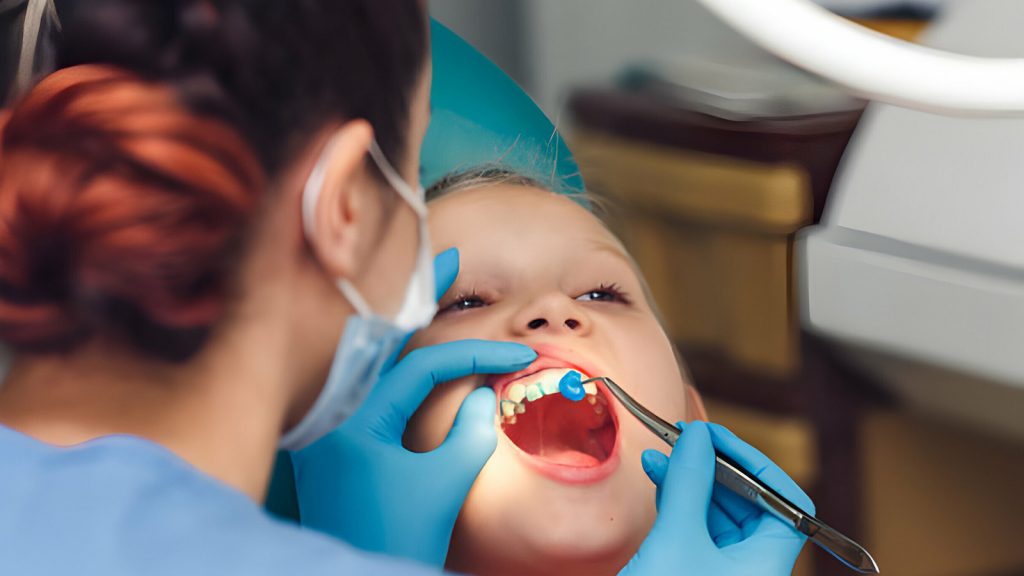
If you are a sweet lover or consume lots of sugar content and fizzy drinks, consider yourself an ideal candidate for the bacteria to grow plaque and form cavities. We become lazy when it comes to cleaning our teeth or maintaining proper hygiene. This is the point from where cavities start to develop.
Maintaining hygiene and consuming less surgery food can reduce its occurrence. If you wonder what does a cavity look like? Or how can I self-diagnose cavities? This blog has all the answers to your questions.
Table of Contents
ToggleWhat are Cavities Look Like?
If you want to know what does a cavity look like? Here is the answer; Cavities are the small holes formed on your teeth’ surface. During the beginning phase of cavity development, you may see a small discoloured spot on your teeth, which you may neglect. But if you leave it untreated it will eventually become a home for bacteria to grow in and cause severe damage to your teeth. Cavities also called tooth decay or dental caries are the world’s most common and noncommunicable health issues. Cavities can develop on the front tooth surface or between teeth which can affect you at any age and gender, even babies can develop cavities.
Symptoms of Cavities
When cavities start to develop, they are mostly symptoms-less as you may only see some kind of spot on your teeth surface. As time passes and their severity increases you may see these symptoms:
- Toothache
- Tooth Sensitivity
- Spots on your teeth followed by holes and pits formation on the tooth surface
- Spots may vary in colour, they can be brown, black, or white
- Moderate to severe pain when you eat or drink something
- Bad breath
- Change in the taste of your tongue
- Swelling
- Bleeding gums
Cavity vs Stain

A cavity is formed due to excessive plaque deposition, bacteria residing in the mouth produce acids that will affect the outer part of the tooth called enamel. As a result, a hole is created which can cause severe pain or tooth sensitivity.
A stain is discolouration on the tooth surface. It is considered an early sign of cavity development. The enamel of your teeth is not affected when the stain starts to develop. But if you ignore it, a cavity may form.
How does a Cavity Develop?
Cavities develop due to several causes and need time to reach in severe form. Certain factors boost the process of cavity formation.
Plaque Formation
Plaque is a clear, sticky substance that covers your teeth. Dental plaques are very common to develop due to excessive intake of sugar and starch in food. Whenever you eat some sugary or starchy food, a thin film of starch starts to deposit on your tooth surface which makes your teeth yellow. You must have to brush your teeth if you want to save your teeth from plaque formation.
Bacterial Growth
Our oral cavity( mouth) contains a large amount of bacteria. Along with saliva, these bacteria help us to decay the food that we eat before going into the stomach. When you don’t brush your teeth, these bacteria start decaying the food on your teeth and as a result release acid. This acid causes the outer part of your teeth damage. If this continues for a long period, it can eventually decay your teeth causing cavities.
Progression of damage
The outer part of your teeth, also called enamel, is hard and resistant to acid. Once bacteria resolve the outer part, they can easily reach the inner soft part of your teeth called dentin. This next layer of teeth is very sensitive and soft and more prone to infections. This innermost part of the tooth consists of blood vessels and nerves. Once bacteria reach there, they damage the soft inner pulp and cause inflammation.
Abscess Formation
If the cavity is left untreated, it can cause the formation of pus or abscess at the tooth root. As the tooth root has nerve and blood supply it will cause inflammation. You may experience tooth pain that radiates to your jaws. Swelling of the face at the affected side and swollen lymph nodes are the common signs of pus formation. This is a severe form of infection that can also spread to your surrounding gums and teeth.
What are the Causes of Cavity formation?
Poor Oral Hygiene
One of the main reasons for cavity formation is not maintaining your oral hygiene. You must brush your teeth two times a day, cleaning your teeth is not sufficient, you must have to clean your tongue as well. Using mouthwash regularly can help you to not develop bacteria.
Poor Nutrition
What you eat matters a lot. Your diet can determine your tooth health as well. Consuming too much sugary and starchy food can cause the bacteria to grow faster, which will disturb your enamel. Similarly, soda drinks can also reduce the mineral content in your teeth and cause them to weaken over time.
Deep Tooth Cervices
People having genetically deep tooth cervices are more prone to plaque formation and cavity formation, as it is hard to clean them properly. This can cause the enamel to decay due to poor hygiene.
Dryness of Mouth
Saliva contains an enzyme called Lysozyme. This enzyme can digest the carbohydrate content of your food in your mouth. It can also damage the plaque layer. People who have dry mouth problems produce a very low amount of saliva which will cause a decreased amount of Lysozyme available in the mouth.
Teeth Grinding
Many people have teeth grinding habits especially when they sleep. This can be due to stress, or anxiety. Grinding your teeth causes the natural enamel to wear out, making it more prone to bacterial infection and other tooth issues like cavities.
Genetics
Some people may develop cavities, as this disease runs in their families. Genetic predisposition is the main cause of tooth cavities.
What are the Risk Factors of Cavities?
Tooth Location
The location of your teeth plays an important role as the back teeth like your molars and premolars are more prone to the source of infection as compared to your front teeth. The back teeth contain several grooves and pits which are difficult to clean and are subject to infections to grow.
Bedtime feeding
Babies are given bottled milk, juice, or several other liquors at bedtime. This can compromise their oral hygiene for several hours as they sleep. The sugar content sticks to their teeth for the whole night and bacteria can grow there causing further damage to enamel.
Fluoride Deficiency
Fluoride is a mineral that can help you protect from tooth decay. It can also reverse or treat the early signs of cavities or tooth decay. For such amazing properties, Fluoride is used in many toothpastes and mouthwashes to control several tooth issues including tooth decay.
Worn out Fillings
Dental filling can wear out over time to make rough edges. This causes the plaque to deposit and bacteria to grow. It can also lead to various other bacterial infections other than cavities or tooth decay, which can be a source of pain for the individual.
Heartburn
Heartburn is the major symptom of Gastroesophageal reflux disease (GERD). In this disease, due to some underlying pathologies, the acid content of your stomach can come back to your mouth. This acid can cause a severe decline in the pH of your mouth causing the outer enamel of your teeth to be damaged. Your dentist may recommend you consult your physician to cure these symptoms.
Eating Disorders
Certain eating disorders like anorexia nervosa and bulimia nervosa can also cause severe damage to your teeth. In these disorders, the person will vomit after every meal which is also called purging. Vomiting many times causes the stomach acids to erode the teeth causing tooth decay and many other tooth issues.
Stages of Cavity
Cavities develop over time so they may look different in every stage of their development. Cavities can develop in any part of your teeth and can affect one or more teeth at once. In the early stage, it is difficult to identify whether you have the cavity or not but as the stage progresses, its severity increases making it more visible and painful. Here are the stages that show what does a cavity looks like from the start to the end stage.
Stage 1: Early Stage of Development
During the early stage of cavity formation, there is no visible sign available. You cannot see the cavity in the early stage with the naked eye. For this purpose, your dentist may ask for a dental X-ray or detect it with specialised tools.
Stage 2: Enamel Damage
As the cavity progresses, it will cause the outer part of the tooth to decay and erode the mineral content. This will result in the formation of white spots on the surface of teeth showing mineral loss.
Stage 3: Dentin Damage
Once the enamel is damaged, the cavity makes its way towards the next layer of the tooth, which is called Dentin. This is the soft layer of your teeth which is more prone to damage and infection. Now, it will turn into a black or brown coloured spot.
Stage 4: Hole Formation
In the severe stage, damage has been caused to the inner part of your teeth. A hole is formed deep inside the teeth causing pain and sensitivity to the affected part.
How Can You Treat Cavities?

Treatment of your cavity depends on the type and stage of it. There are many treatment options available but it is advised to always ask your dentist about your cavity stage. They can recommend you the best possible treatment options by diagnosing what your cavity looks like. Or what stage is your cavity?
Fluoride Treatment
If you have a tooth cavity at an early stage, fluoride treatment is the best treatment option. It is a natural mineral and helps to reverse the early decay. It is available in different toothpaste and mouthwash, so you can use them to reverse the early demineralization of enamel. You can also take this treatment in dental clinics under the supervision of your expert dentist.
Dental Fillings
Once your tooth has entered into the severe stage of cavity formation, your dentist will extract all the damaged parts of the tooth and fill it with dental filling. Dental fillings are tooth-coloured materials made of silver amalgam and gold. These are single or mixtures of metals, plastic, or glass and help to restore the normal integrity and function of your tooth.
Root Canal Treatment
Root canal therapy is done by endodontists, who are tooth root specialists. This treatment is mainly performed to relieve pain and remove infection. If the infection persists inside the tooth, it will not only erode the whole tooth but also infect the surrounding gums and teeth as well. So, it is very important to remove the infection. For this purpose, your dentist removes the infected part of the tooth and disinfects it. The tooth canal and pulp area are then filled with a special root canal material called gutta-percha. Sometimes, dental crowning is also done to provide strengthening for the infected and weak tooth.
Dental Crowning
Dental crowning is a procedure in which the dentist removes a decayed part of the tooth. This will help to prevent further spread of damage. Once the damaged part is removed, they will place a customised cap on your natural tooth. This will also provide strength to the damaged part of the teeth.
Tooth Extraction
If you have left your cavity untreated and now it has damaged all the teeth from the inside, then it is just an infection hub. It will further damage the surrounding teeth and cause more infections. So your dentist may recommend you to remove it before it spreads further infection. In the process of tooth extraction, your dentist removes the infected and decayed tooth from the root. After a certain time gums heal and they are ready for tooth implant.
How Can You Prevent Cavities?
- Brushing your teeth with a soft brush twice a day, especially after a meal
- Use fluoride-based toothpaste and mouthwash
- Daily dental floss helps you deep cleanse the teeth’ corners
- Avoid the use of a high-sugar diet and brush your teeth after sugary intake
- Consider using dental sealants, as they coat the upper part of your teeth and prevent them from accumulating food that is difficult to brush off
- Timely dental checkups are important
- Consider periodic fluoride treatments, as it will prevent the risk of getting any infection or decay
- Eat good and healthy food like fruits and vegetables
For the best dentist Sherman Oaks, LA . Contact us today!
The early stage of the cavity does not show any visible sign, wherever an X-ray can help to detect it. In the late stage, a white spot may appear showing enamel erosion progressing towards a darker spot showing the severity and spread of the infection.
Since the infection affects the root of your teeth, it will cause inflammation. The common signs of inflammation include pain, swelling, and increased local temperature.
Tooth sensitivity at the late stage is very common whenever you eat or drink something cold or hot.
A cavity cannot go away on its own, once a cavity starts to develop it will continue to proceed until properly treated. The main reason behind this is the enamel of the tooth does not contain cells that can regenerate themselves to compensate for damage. When the bacteria start eroding tooth enamel, they will not stop until the whole tooth is decaying. You must seek medical attention once you start seeing the symptoms mentioned above in this blog.
At the beginning, a cavity will show up as a white spot on the tooth surface that shows mineral resorption from the enamel. After that, when left untreated, it will continue to form a dark discoloured spot. The bacteria can spread the infection to the dentin and then the pulp of the tooth creating a visible hole.
The dark spots on your teeth can be cavities. They are in various colours, like at the early stage they are white in colour also called white tooth cavity but after severe infection, they turn into dark brown or black spots that show tooth decay.
A cavity may vary in colour in different stages of its development. During the start of enamel erosion, it will appear as a faded white spot. When it progresses, it converts into a dark brown or black colour cavity representing infection and damage.
A white cavity appears at the initial stages of tooth decay. When the enamel is affected by bacteria and acid attacks, the mineral content errors very fast producing a white spot. You must consult your dentist, once you see the symptom because it can lead to cavity formation.
It could appear as a brown, black, or white spot on the tooth’s surface. As the cavity enlarges, it becomes more prominent, potentially transforming into a pit or a darker region on the tooth.
Rest assured, a cavity on a molar is entirely treatable! Having a cavity simply means there’s a small hole or damage in your tooth caused by bacteria.
